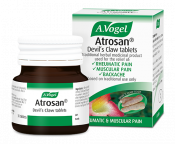How do painkillers work?
NSAIDS or Nonsteroidal Anti-Inflammatory Drugs are usually taken to help reduce the amount of inflammation present in the body. They work by reducing the production of prostaglandins, chemicals that promote inflammation, pain and fever. Prostaglandins also protect the lining of the stomach and the intestines from the damaging effects of stomach acid, encourage natural blood clotting by activating blood platelets as well as promote the normal functioning of the kidneys.
There are two types of enzymes that produce prostaglandins called cyclooxygenases COX-1 and COX-2. NSAIDs work by blocking COX enzymes which reduces the production of prostaglandins and therefore also reduces the amount of inflammation, pain or fever in the body. Different NSAIDs differ in their strength and duration of action, their differences in their ability to inhibit COX-1 and COX-2 means that their side effects may also differ.
What does the research say?

NSAIDS are among the most commonly taken pain relief medication. However, one study looking at our relationship to how many painkillers we take has found some truly alarming results.
The study contained 1,300 participants who completed a 1-week online diary which showed that over 90% took over-the-counter ibuprofen. What’s more, 37% of participants also took another NSAID during the week such as aspirin or naproxen without realising that they were taking multiple NSAIDs. Another concerning result of this study was that 15% of NSAID users exceeded the recommended dosage limit. Over half of participants (55%) took ibuprofen at least three days during the week and 16% took it every day.
Taking above the recommended daily amount of painkillers can have disastrous effects on our health! Overdosing on NSAIDs is linked to numerous adverse effects such as having a higher risk for heart attack, gastrointestinal bleeding and liver damage to name a few. What’s more, these results are heightened if NSAIDs are taken for a long period of time. People over the age of 60 are particularly vulnerable to high blood pressure and kidney damage as a result of taking too many NSAIDs.
However, the study acknowledges that this may only be true for those who take NSAIDs consistently and may not apply to those who need them infrequently or those who are new to taking them. Therefore, further research is still needed to truly understand our relationship to these painkillers.
Many people also use NSAIDs for other indications such as flu, allergies and hayfever despite the fact that there is no firm medical grounding that these types of painkillers would even be beneficial for these cases. This only adds to the risk of NSAID overdose and could potentially make the problem worse.
How to prevent overdosing on painkillers

When we feel as though the recommended dosage isn’t giving us the sufficient pain relief that we need it can become all too easy to take more. However, as I have mentioned, this reliance on painkillers isn’t an effective way to manage our pain and it can have disastrous effects on our body later down the line. That being said we also shouldn’t suffer at the hands of our pain and should absolutely look for ways to provide relief. To help to prevent taking too many painkillers and risking an overdose follow these handy tips:
• Check if you need to avoid some foods – some NSAIDs should be taken alongside a meal whilst others can interact with certain foods and alcohol causing uncomfortable side effects so be sure to read the labels and to double check with your doctor before taking them.
• Physiotherapy and movement – for muscle and joint pain keeping the body moving helps to lubricate the joints and prevent stiffness from causing additional pain. It may also be worth investigating a local physiotherapist who will be able to provide you with advice on the best course of movement you should be taking.
• Follow your doctor’s advice – when it comes to medication it is so important to discuss any queries and questions you have with your doctor. If you are taking over-the-counter NSAIDs alongside prescribed medication confirm with your doctor that your NSAIDs won’t interact with any of the medication that you are already currently on.
• Read the label and get to know your NSAIDs – NSAIDs come in many shades and forms including both over-the-counter and prescribed types. Be sure that you don’t ignore the recommended daily amount on the label – because it is there for a reason!
• Do you really need a painkiller? – to prevent relying on your painkillers like a crutch it is important to know when you really have to take them and when you could perhaps do without or opt for another form of pain relief.
• Get a helping hand from herbs – herbal remedies can be much more beneficial for the body as they don’t have the same toxic side effects that can be associated with NSAID overdose. For muscle and joint pain I’d suggest our Atrosan Devil’s Claw tablets to help naturally provide some pain relief. The good news is this friendly remedy can also be taken alongside painkillers with no unwelcome side effects.
1 https://www.rxlist.com/nsaids_nonsteroidal_antiinflammatory_drugs/drugs-condition.htm
2 https://www.medscape.com/viewarticle/892454
3 https://onlinelibrary.wiley.com/doi/abs/10.1002/pds.4391
4 https://www.everydayhealth.com/nsaid/guide/









